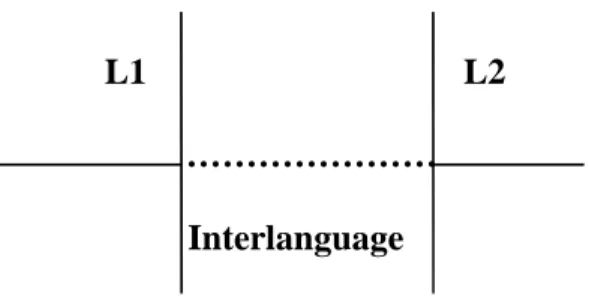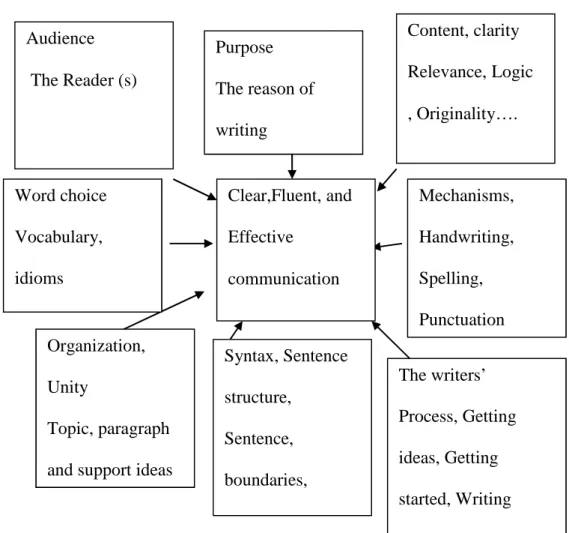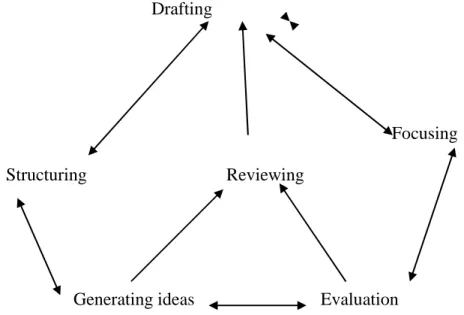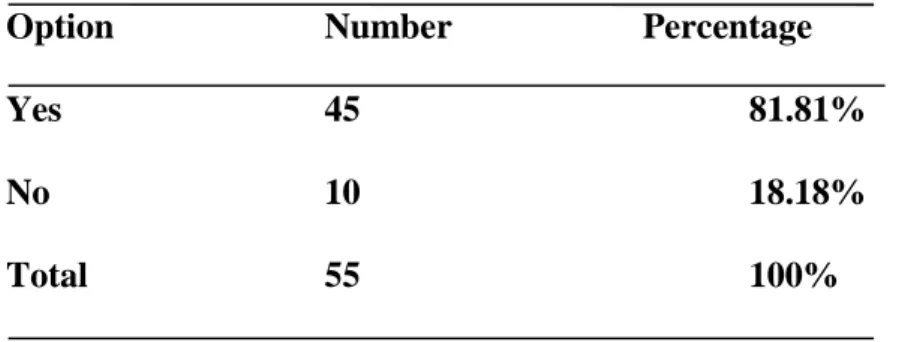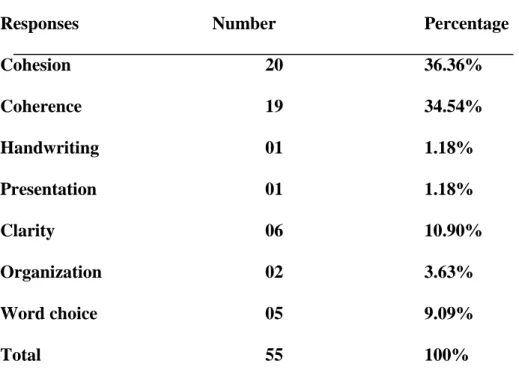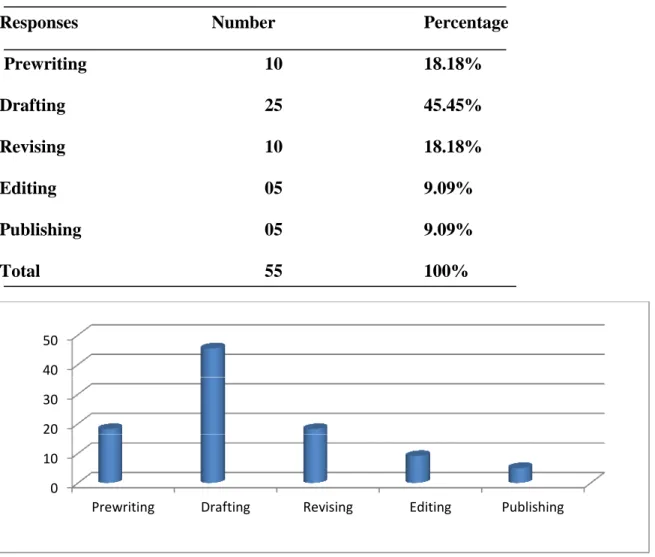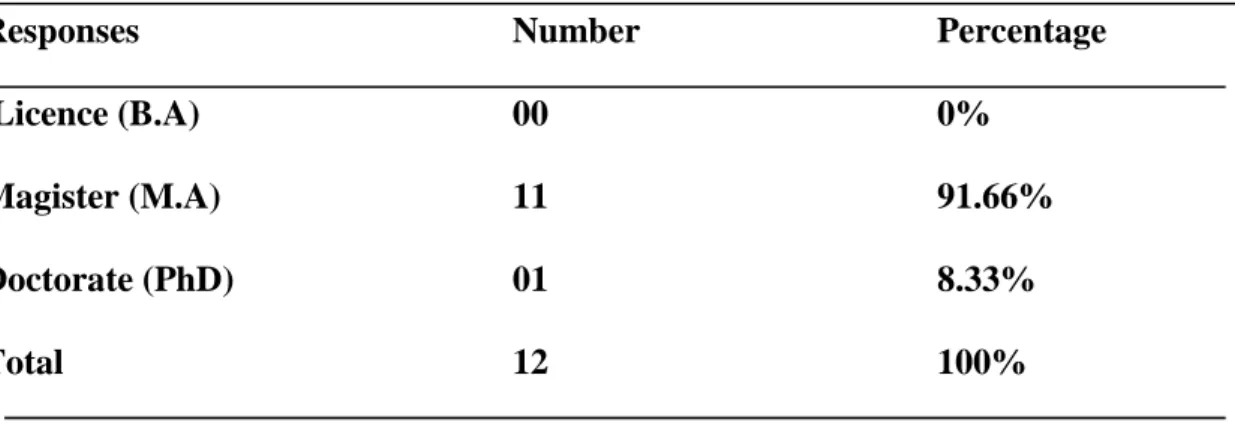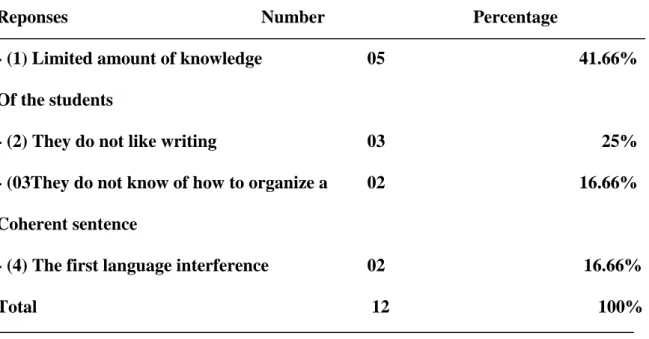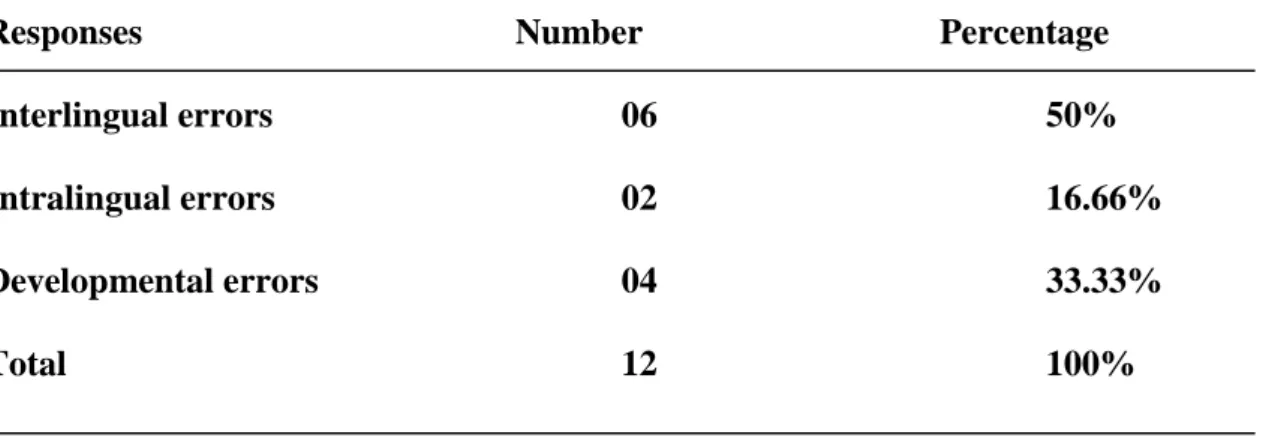People’s Democratic Republic of Algeria Ministry of Higher Education and Scientific Research
8 MAI 1945 UNIVERSITY / GUELMA ﺔﻤﻟﺎﻗ /1945 يﺎﻣ 8 ﺔﻌﻣﺎﺟ FACULTY OF LETTERS AND LANGUAGES تﺎﻐﻠﻟا و بادﻵا ﺔﯿﻠﻛ DEPARTMENT OF LETTERS & ENGLISH LANGUAGE ﺔﯾﺰﯿﻠﺠﻧﻻا ﺔﻐﻠﻟا و بادﻵا ﻢﺴﻗ
Option: Linguistics
The Impact of First Language “Negative Transfer” on EFL Learners’
Writing Proficiency
The Case of Second Year LMD Students of English at the University of 8
Mai 1945, Guelma
A Dissertation Submitted to the Department of Letters and English Language in Partial Fulfillment of the Requirements for the Degree of Master in Anglophone Language,
Literatures, and Civilizations.
Submitted by: Supervised by:
Ms. ABDELMALEK Hanane Mrs. BESKRI Yamina
BOARD OF EXAMINERS
Chairperson: Mrs. SERHANI Meriem Maitre Assistant “A” University of 8 Mai 1945- Guelma
Supervisor: Mrs. BESKRI Yamina Maitre Assistant “B” University of 8 Mai 1945- Guelma
Examiner: Mr. CHETTIBI M. Walid Maitre Assistant “B” University of 8 Mai 1945- Guelma
DEDICATION
I dedicate this humble work to the apple of my eyes:
My dear parents:”HAMID and YAMINA”, for their great support, help and guidance, endless love. They devote their time, energy to stand by my side along with this journey of five years to make me who i am today.
May Allah bless them and keep them for me.
To my beloved brother “SALEH’’ who deserve to be called my second “Father” To my second brother “ADEL” and sister: SALWA.
To my best friend: CHAIMA, NESSRINE, IKRAM, MERIEM.
To my best teachers in the English department: Mrs. BESKRI Yamina,Mrs.CHEKAT Ilhem and Mr. Walid M CHETTIBI.
Finally to all people who provided me with help, smile and patience to make this research possible.
ACKNOWLEDGEMENTS
We would like to express our gratitude and appreciation to our supervisor: Mrs. BESKRI Yamina for her great guidance, support and help and we are heartly indebted for her kindness throughout the conduction of this research.
We would like to thank the examiners for their acceptance and their constructive judgment to our dissertation.
We are sincerely appreciated your awareness, and careful reading of this dissertation: Mr. CHETIBI Mohemmed Walid, and Mrs. SERHANI Meriem.
Special thanks go to my teacher: Mrs.CHAKET Ilhem, for her help and encouragement.
Finally, our huge and endless thanks go to our grateful teachers, who have been teaching us during these five years, and unforgettably the teachers and the students who kindly answer the questionnaires.
ABSTRACT
The present dissertation attempts to investigate the influence of the First Language “Negative Transfer” on the student’s writing proficiency, at the Department of English, University of 8 Mai 1945, Guelma, Algeria. The purpose of this study is to examine the effect of L1 “Negative Transfer” on EFL learner’s writing. The research study sample was randomly chosen from second year LMD population of the English Department. In order to test the hypotheses that suggest the probability that the EFL students with low level writing proficiency tend to use their first language “Negative Transfer” during the writing process. In this respect a descriptive method has been adopted, in which two questionnaires were administered and test that is administered to the same sample of the second year LMD students; the student’s questionnaire was directed to sample group (55) of second year LMD students who were assigned randomly; whereas, teacher’s questionnaire was addressed to (12) English teachers of “Written Expression” module from the English Department. Hence the aim of two questionnaires and test were to collect significant information about effect of L1” Negative Transfer” on the writing proficiency, and to show the attitudes of the students towards the L1 influence. As a result the findings have shown that the First language “Negative transfer” affects negatively the EFL learner’s writing proficiency. Moreover, the results of the questionnaires and test have confirmed the research hypothesis. In this light, the low level of the student’s writing proficiency is due to the L1 “Negative transfer” and they need to develop the foreign language background that enhances their writing proficiently, in order to reduce the impact of L1 transfer.
Key Words: First language, Foreign language, Negative transfer, Language transfer, EFL,
LIST OF ABBREVIATIONS
CAH: Contrastive Analysis Hypothesis EFL: English as a foreign language ESL: English as a Second Language ELT: English Language Teaching LMD: License Master Doctorate LT: Language Transfer
LL: Language Learning MT: Mother Tongue NT: Negative Transfer PT: Positive Transfer
STL: Second Teaching Language SLA: Second Language Acquisition TL: Target language
LIST OF TABLES
Table01: Age distribution ……….. …41
Table02: Students’ experience in learning English………42
Table03: Students’ choice of English ………43
Table04: Description of students’ level in English ………44
Table05: Description of students’ level in writing………..44
Table06: Description of students’ opinions about the difficulty of the writing task………..45
Table07: Frequency of the students’ writing proficiency………..47
Table08: Description of student’s opinions towards the “Written expression” course …….48
Table09: Student’s views about the effectiveness of the writing components ……….49
Table10: Stages that students do not follow when writing………50
Table11: of student’s attitudes towards the impact of the first language on writing……….51
Table12: Description of students’ opinions about the use of L1 in the classroom………….52
Table13: Students’ opinions of views about the difficulty of expressing ideas in English...52
Table14: Description of students’ rank of the statements ………..56
Table15: Students’ attitudes towards the use of translated expressions in writing………….56
Table16: Teacher’s qualifications………...57
Table17: Teacher’s experience in writing………...58
Table18: Description of teachers’ views towards the difficulty of writing task ………58
Table19: Description of the approaches to teach writing ………..59
Table20: Description of teachers’ views towards the use of the writing stages ……….60
Table21: Teachers’ answers about the reasons behind the students’ levels in writing……...61
Table22: Teachers’ rating of the students’ level in writing……….61
Table25: Teachers’ views towards the use of L1 of the students’ ideas………64 Table26: Teachers’ frequency about the L1 use in writing………65 Table27: Description of teachers’ ranking of the reasons behind the L1 transfer…………..66 Table28: Teachers’ views towards the students’ consciousness of L1 use in writing………66 Table29: Teachers’ observations of the students’ errors in L2………..….67 Table30: Teachers’ views towards the impact of the L1 of students’ writing………68 Table31: Teachers’ views towards the effectiveness of the English –Arabic dictionary …..68 Table32: Teachers’ views towards the usefulness of the translated Arabic-English
expressions………...……68
LIST OF FIGURES
Figure01: Producing a piece of writing ………04
Figure02: Process of writing………. …...09
Figure03: Procedures involved in producing written text form process writing………13
Figure 04: Process of writing ……….28
Figure05: Procedures involved in producing written text form process writing………31
LIST OF GRAPHICS
Graph01: Student’s choice of English………41 Graph02: Description of the students’ level in English………..…42 Graph03: Description of the student’s level in writing………...…43 Graph04: Description of the students’ opinions about the importance of writing
proficiency………....45
Graph05: Frequency of the students’ writing proficiency………..46 Graph06: Description of the student’s opinions about the “Written Expression” course…..47 Graph07: Description of the student’s about the effective components in writing………....48 Graph08: Description about the stages that are not followed by students in writing………49 Graph09: Description of the students’ attitudes towards the impact of L1 on the Writing
CONTENTS
DEDECATION………I
ACKNOWLEDEGEMENTS………II
ABSTRACT………...III
LIST OF ABBREVATION………..IV
LIST OF TABLES……….V
LIST OF FIGURES………VI
LIST OF GRAPHS………XII
General Introduction……….1
1. Statement of the problem………..1
2. Research Questions..………2
3. Aims of the Study……….2
4. Research Hypothesis……….3
05. Research Methodology and Design………3
5.1. The method………3
5.2. Population of the study ……….3
5. Pilot Study………4
5. 3.Data gathering tools ……….. …...4
6. Structure of the dissertation ……….4
CHAPTER ONE: THE FIRST LANGUAGE
“NEGATIVE TRANSFER”
Introduction………6
1. Overview about the first language transfer………7
2. Definition of “Transfer” (Interference)……….8
3. Types of transfer……….…..9
4.2. Positive transfer……….11
4.3 Negative transfer………12
2.4.Interlanuage and Transfer………..…12
4. Types of the errors………...13
5.1. Interlingual errors………..15
5.2. Intralingual errors………..15
5.3. Developmental errors………16
6. The impact of the L1 transfer on the L2 writing proficiency………..16
CHAPTER TWO: THE WRITING PROFICIENCY
Introduction ……….20
1. Definition of Writing………20
2. The Nature of Writing………..22
3. The acquisition of Writing ………..24
4. Teaching Writing ……….24
4.1. The process of Writing ……….24
4.1.1. Pre-writing………..24 4.1.2. Drafting/Composing………..25 4.1.3. Revising/Reviewing………...26 4.1.4. Editing………27 4.1.4. Publishing………...27 4.2. Approaches of Writing………..28 4.2.1. Product Approach………...28 4.2.2. Process Approach ………..29 4.2.3. Genre Approach ……….31
5. Components of effective Writing……….33
5.1. Components of the form………34
5.1.1. Mechanisms………34
5.1.1.1. Presentation………..…34
5.1.1.2. Handwriting……….34
5.1.1.3. Indentation………...34
5.1.1.4. Punctuation……….34
5.2.2. Word choice………35
5.2.3. Clarity ………36
5.2.4. Coherence ………..36
5.2.5. Cohesion………36
6. Writing with Other skills ………37
6.1. Writing and Speaking ………...37
6.2. Writing and Reading ………38
CHAPTER THREE/FIELD INVESTIGATION
Introduction………...39
1. Students’ Questionnaire……….39
1.1. Aim of the students’ Questionnaire………....39
1.2. Sample Choice……….40
1.3. Description of Students’ Questionnaire………...40
1.4. Administration of Students’ Questionnaire……….40
1.5. Analysis of Results and Findings………..40
1.6. Summary of the Results and Findings from Students’ Questionnaire…………..53
2. Teachers’ Questionnaire………..54
2.1. Administration of the Teachers’ Questionnaire………55
2.2. Description of the Teachers’ Questionnaire………..55
2.3. Analysis of the Questionnaire………...…55
2.4. Summary of the Results and Findings from the Teachers’ Questionnaire………67
3. Student’s Test………..70
3.3.1. Description of Students’ Test ………...70
3.3.1. Aim of Students’ Test……….70
3.3.1.2. Sample Choice……….70
3.3.3. Analysis of Test’s Results………...…71
General Conclusion ………71
RECOMMENDATIONS
………72REFERENCES
………..75APPENDIXES
Appendix II: Teachers’ Questionnaire Appendix III :Students’ Test
French Abstract Arabic Abstract
Introduction
Writing is considered as one of the main pillars of mastering the English language. Despite the writing instructions that learners had received, they still use some structures, vocabulary, rhetorical patterns of their first language when writing a piece of English language. Hence, researchers have put much attention on L1interference as linguistic phenomena which may lead to low writing proficiency and inefficient academic achievement. Therefore, writing is another form of communication that encompasses words, symbols all governed together to express a certain aim.
Most of foreign language student’s errors are due to “the negative transfer” that happens when the speakers and writers transfer items or certain structures that are not common in both languages; in the sense that the more there is differences exist between two languages, the more negative transfer is possible to occur. Additionally, negative transfer turns around the influence of the learner’s native language on the foreign language acquisition. So, the impact of the negative transfer on the writing proficiency is a worthy research to be investigated to shed light on the students writing problems in order to get rid of it and to achieve a good academic level of the English language.
1. Statement of the problem
Writing skill had received much interest as an important pattern and for many decades English learners faced many problems when writing well organized and structured piece of language. The main remarked problem is that the majority of the student’s writing at the English department, Guelma university has showed that, the native language transfer may influence the learner’s writings proficiency. Hence, their writing proficiency is low, due to many factors namely the lack of understanding the meaning of the text ,identifying new
use of language, consequently, their native language background would be less interfered when writing the English writing tasks.
2. The research Questions
To know better about these linguistic phenomena the research will stress on this problematic issue, this research addresses the main following question;
1. Is the low level of students writing is due to the negative impact of the first language “negative transfer”?
2. What are the attitudes of both students and teachers towards the use of the negative transfer?
3. What is the impact of the first language “negative transfer” on the student’s writing proficiency?
3. The aim of the study
The present research is conducted to reach the following aims and goals:
1-To explain the reason behind the first language use and whether its application has a negative or positive impact on the student’s writing proficiency.
2-To find out successful strategies and solutions that may help the English learners to write the target language without L1 interferences
4. The Hypothesis
The L1 “negative transfer” is one of the crucial problems that the English learners may encounter which may lead to a low writing proficiency. So, we hypothesize that learners with low level writing proficiency tend to use their fist language “negative transfer” when writing in English. If students did not use their first language negative transfer, their writing proficiency would increase. Thus, there is a relationship between the two variables. Writing proficiency would be increased when the first language negative transfer is less used by the English students.
5. Research Methodology and Design
5.1. Choice of the Research Method
This research would be conducted through the quantitative descriptive method aiming at confirming the above mentioned research hypothesis through administrating two questionnaires and test students’ questionnaire would provide us with reliable information about student’s English writing and to which extent their target language is influenced by their mother tongue.
5.2 Population of the Study
The research population represents English students at English department at Guelma University. The sample is chosen randomly which consists of 55 students of second year English students from 200 students as the whole population. Second year students has chosen to the study because they are English beginners and their first language background is more than the target language, thus their first language negative interference is more noticed than the advanced students. Also, the population is suitable for our research.
5.3. Pilot Study
The researcher used two questionnaires to reach a good aim; the students and teacher’s questionnaires. 15 students took part in the piloting of the students ‘questionnaire in which they react about some abbreviations and some terms, hence, through their feedbacks the researcher has modified the questionnaire to suit the students level.
5.4 Data Gathering Tools
Our research is relied on administering two” teachers” and “students” questionnaires in addition to test, at the English department university of Guelma ,Algeria to the second year English student to provide us with information about the factors of the first language negative transfer when students do the written task and does this strategy is good for acquiring the target language writing proficiency. However, teacher’s questionnaire is used to account for the teachers’ experience about the writing skill teaching, in addition to their opinions about the use of L1in English writing. Hence, the questionnaire is appropriate for our research because it allow us to collect data about the subject matter for the aim of analyzing information and reach good results.
6. Structure of the Dissertation
This dissertation consists of two parts: “the theoretical part” and “the practical part “the former is dived into two chapters ,the first one tackles the description of the writing skill, the relationship between writing and other language skills, components of writing, approaches to teaching writing, and the writing requirements. The second chapter provides overview about first language negative transfer and shows the impact of the negative transfer on the writing proficiency. Finally, Chapter three is entitled “Field of investigation”, it includes a description of both student and teacher’s questionnaires and test and its
administration, description, analysis, and interpretations. Finally the research is ended up with a general conclusion that closes the topic.
Conclusion
The research is prompted by the desire to examine the importance of making student’s writings grammatically organized and well structured. Correspondingly, they can enhance their writing proficiency. Through the use of the questionnaires many opinions of teachers and student’s level about the writing proficiency could be identified, and the impact of the first language negative transfer would be decreased, the results of the questionnaires and the test will confirm or reject our above mentioned hypothesis.
CHAPTER ONE: THE
FIRST
LANGUAGE « NEGATIVE
TRANSFER »
General introduction
Over the past years first language transfer has been a key issue in the field of teaching the second language, (SLA). the questions of first language transfer “Interference” has attained a remarkable English language researchers to investigate about it. Hence, teaching a foreign language requires great attention from both learners and teachers, to bear in mind that, two or more languages, permanently present in the student’s mind.In this chapter there are some key concepts related to the first language “Negative Transfer” and the second language. Therefore, the chapter includes an overview about the first language transfer and its history and nature, in addition to the definition of the language transfer. Also the chapter summarises the types of transfer; Negative transfer and Positive transfer. Furthermore the chapter end up with discussing the concept of Interlanguage and transfer and the different errors produced by the EFL learners, Interlingual errors, intralinguagl errors ,and developmental errors. Finally we will discuss the effect of L1 negative transfer on the writing proficiency. Consequently, we will tackle mostly all the issues and the problems that the learners may face in learning the TL.
2.1.
Definitions of key terms related L1 and L2 The foreign language (FL)“It is one not widely used in the learner’s immediate social context which may be used for future travel or other, cross cultural communication situation in schools, but with no immediate or necessary practical application” Troike (2006).
Foreign language learning (FLL)
It is generally differentiated from second language acquisition in the sense that, the former refers to the learning of a non native language in the environment of one’s native language. Ellis (1994, p.26)
Second language acquisition (SLA)
“Refers to both to the study of individuals and groups who are learning a language subsequent to learning their first one as young children, and to process of becoming and “educational individual” Troik (2006).Moreover, the online dictionary defines second language as “a language other than the mother tongue that a person or community uses for public communication, especially in trade, higher education and administration”. (The free dictionary by Farlex).According to Ellis (1994), SLA refers to the process of learning another language after the native language that has been learnt also, the term can refers to the learning of 3rdand 4th language and it can refers to learning of non-native language after learning the native language. Therefore, Second language acquisition can simply defined as the learning of non-native language in the environment, in which that language is spoken.
Second language (SL)
Is non-native language officially recognized and adopted in a multilingual country as a means of public communication, it is called the TL, which refers to any language that is the aim and goal of learning. Troike (2006)
Ellis (1994) defines the foreign language as the language that is acquired after the first language however, according to Sinhano et al, (2009) second language is typically an official or socially a dominant language needed for education, employment, and other basic purposes, and it is often acquired by minority group members or immigrants who speak another language natively.
Native language (NL)
It refers to the first language that a child learner, it is also known as the primary language, the mother tongue, or the L1. Ellis (1994, p.26)
Target language (TL)
“Refers to the language being learnt” Ellis (1994, p.26)
Second language studies (SLS)
The term refers to anything deals with using or acquiring a second /foreign language. Ellis (1994, p.26)
2.2.
Overview of First language TransferFirst language transfer has many synonymies and definitions such as:“Cross meaning” Interference” L1 interference”, “Linguistic interference” or “Cross linguistic influence”. Language transfer is when the learner apply rules and forms of the first language to second language, Skiner (1957) and Waterson (1924) ,Pavlov (1936) and Thorndlike (1936) believe that a child’s present learning is influenced by his past learning, in the sense that they had proved that the stored knowledge of the learner’s mother tongue would ease the teaching of the second language ,and if the structure of both language is similar, the first language habits will be helpful and useful to acquire the second language habits, however; if the two languages are different it will be difficult for the students to acquire the second language.
familiarity with more than language. However, according to Corder (1992) refers to the phenomena as “mother influence “by recognizing the L1 influence on the foreign language production also, he stressed the fact that the Learner cultural experience will interfere with the learning of FL ’patterns’ that function differently in the learner’s culture.
According to Gass (1996) transfer is the use of the mother tongue or other language information in the acquisition of an FL. However, Odlin (1993) has reinforced the previous definition of transfer in which he refers to it as “is the influence resulting from similarity and differences between the target language and other languages that has previously and perhaps imperfectly acquired” (p.51)
2.3.
Definition of the language Transfer (Interference)The term “Transfer” refers to taking something from “x” situation and put it in situation where the context is different, in other words the term transfer mostly refers to a negative situation, Ellis defines transfer as “L1 transfer refers to the influence that the learner’s L1 exerts over the acquisition of an L2”.According to, the Behaviorist view transfer is “a habit formation” which means that, native language habits can be translated to foreign language. Therefore, Lado (1957) says clearly:
Individuals tend to transfer the forms and meanings, and the distribution of
forms and meanings of their native language and culture to foreign language and culture to foreign language and culture-both productively when attempting to speak the language and to act in the culture, and receptively when attempting to grasp and understand the language and culture as practiced by natives.
Additionally, Transfer is related to the productive and receptive skill either in form or meaning .In other words, EFL learners make transfer both in speaking and writing. According to Corder 1975 explains transfer saying that, the learner carries the habits of his or her mother tongue into the second language, when there a similarities between learning the TL and the
mother tongue .Thus, TL is easy trough the positive transfer, however; when there is differences between learning the TL and the mother tongue, TL would be difficult and it results negative transfer through the occurrence of errors. Temmime (2009) declares that language Transfer has different names used by researchers namely; Selinker(1972) and Kellerman, (1983) called it “ Language mixing” ,Schacher and Rutherford (1979),and Ringbon (1987) named it “Linguistic interference”. However, Lado (1957) and Selinker (1972) called it “Language transfer”
The concept of transfer “Interference” was first given by Wienrick (1953).Lado (1957) claimed that the second language learner has already stored set of habits of the mother tongue in the sense that, some of the earlier habits would help the learner to learn a new language. However, some other rules and structures will create linguistic problems to the leaner since, the L1 differs from L2.However, in terms of foreign language teaching and learning, transfer refers to the influence of the learner’s native language on a foreign language acquisition, in which the important units or structures of both languages share similarities (Lado 1957).Therefore, the notion of transfer is originally related to behaviorism (Lado’s work 1957), where Fries states:
Learning a second language, therefore constitutes a very different task from learning the first language, the basic problem arise not out of any essential difficulty in the features of the new language themselves but primarily out of the special “set” created by the first language habits
This means that, individuals transfer the meanings and the forms of their native language and culture to the foreign language and its culture.
In the early of 1970’s transfer was challenged in the sense that many studies have carried out to prove that not all the instances of transfer were predicted by CA (Raven 1978), however, the process of acquiring L2 was very similar to the L1 Dulay and Burt
(1973).Moreover, transfer from the native language is considered as a form of influence of L1 habits on L2 learning Fries (1949) argued that L1 interference is one of the main obstacles for students who try to learn the second language in which he stressed on the comparison between a learner’s native language and the target language since, they are important ways for L2 likewise, Lado (1957) he considers the ML proficiency as the major cause behind the failure in learning the L2.
According to, Perkinson (1992) he defines transfer as “When learning in one context enhances or undermines a related performance in another context”. Researchers have provide different definitions to the concept “Transfer” Brand &Brown (1999) defines transfer as the ability of extending what the learner has been learned in one context to the new context, this means that the leaner reuse his /her exercised habits of the L1 and apply it on the L2 learning. Alexander and Muphy (1992) defines transfer as “The process of using knowledge or skills acquired in one context in a new or varied context”
To conclude, Language transfer or “Cross linguistic influence as it is called by Kellerman and Sharwood (1986) may result in accurate language production which is called “Positive transfer” i.e. when the first language and the target language are similar, as a result, those similarities facilitates learning, however, when there is a great differences between the target language and the first language structures errors are expected to commit by the learner which is called “Negative transfer”
2.4.
Types of Language TransferEllis (1994) illustrates different kinds of transfer through her quotation stating that: Transfer is to be seen as a general over term for a number of different kinds of influence from languages other than the L2, the study of transfer involves the study of errors (negative transfer),facilitation (positive transfer),avoidance of target language forms and their over-use.(p.25)
According to Ellis’s quote there are different types of language transfer, however, positive transfer and negative transfer are the most common ones
2.4.1.
Positive transfer “Facilitation”Positive transfer is beneficial part of the L1 in L2, it occurs when the mother tongue and the target language are structurally the same, in other words when the two languages share the same characteristics, hence ,Robert Lado (1957) summaries the learner’s problem in his well know formation stating that “Those elements that are similar to his native language will be simple for him, and those elements that are different will be difficult”(Littlewood,1984),therefore, this kind of transfer is rarely occurring, as a result,it was neglected by researchers, Allen and Corder (1957) maintain that “positive transfer help new learning”
E.g: it is easy to learn and pronounce aspirated voiceless stops in L2 in the language that has aspirated voiceless stops.
2.4.2.
Negative TransferRefers to the negative influence that the knowledge of the L1 has in the learning of the target language due to the differences existing between both languages, in other words negative transfer happens when the learner transfers items, structures that are not the same in both languages, and it has been noticed that the learners sometimes use the stylistic habits of the first language intentionally, as a result frames, sentences will be similar to the mother tongue which results errors if the syntax of the L1 is different from the L2.Setjiit Kaun (1993,p.54) gives example of lexical, grammatical transfer..
E.g:
a) He will not do marriage with her b) Midas thought he was taking dreams
Moreover, some linguists refers to the negative transfer as interference, Weinreich clarifies that when the process of L2 is taking place and if the linguistic features of the L1 are similar in form, meaning distribution will be regarded as facilitating the process, and transfer seen as positive, however, if they are dissimilar, the transfer is considered as negative, thus, the acquisition of the target language will be seen as distorted due difference in the two structures whereby ,Weinreich called this phenomena as “Interference”.
2.5.
The Interlanguage and the TransferWhile learning a second language learners produce utterances which are ungrammatical and ill formed, Corder (1987, p.66) called the word interlanguageas as“Idiosyncratic dialect” 1971, which refers to the foreign or second language that learner’s go through when moving from the mother tongue to learn the TL, also he clarifies that the study of interlanguage is the study of the learner’s language. Moreover, Corder (1957) argued that, the learner has a unique dialect (Language) which is regular, systematic, dynamic, and meaningful, and it is independent system that has a communicative purpose and specific features. Corder (1981) states that EFL learner posses a degree of competence in the second or foreign language learning which called “Transitional competence” (p, 10) which means that ,interlanguage is like any independent system. However, Nemser (1960) refer to the term interlanguage as “ The approximate system”, and he is the first one who mentioned the term “Deviant learner language” which refers to a learner’s speech at a given time ,and it is the patterned product of a linguistic system distinct from mother language and target language and it is internally structured.
Larry Selinker (1972), defines interlanguage as; the state of language learner in between the L1 and L2 as an intermediate state, whereby, the learner go through different steps and phases from L1 to acquiring the L2.Moreover, IL although has been used in relation with SLA, but it has been extended for use in L3A, in other words, the EFL learner at any
particular moment in his or her learning sequence is using a language system, and it is neither native language, nor a TL. Also, interlanguage is a unique language with its own system :grammar, lexicon…Therefore, the learner’s rules of his/her interlanguage cannot found in his or her own mother tongue nor in the TL, it is a language system in its own right.
First language
Second language Interlanguage (Learner’s independent Other influences Language)
Figure 01: Interlanguage (Ellis, 1994)
Transfer is one of the most important elements that affect the interlanguage system forms, which can lead to better understanding the second language, Lado (1957) believed that people rely on their L1 when learning the TL, however, other researchers Dulay and Burt (1974,p.24) transfer has nothing to do with interlanguage but it should be considered.
L1 L2
……… Interlanguage
Figure 02: The scope of Interlanguage (Cited in TemmimiAsema, 2009)
Selinker (1972) states that language transfer is one of the cognitive processes that occurs during the interlanguage development in second language acquisition, in addition to transfer of training that refers to how the L2 is thought and strategies of L2.Hence, Selinker adds that only 5% of EFL learners can achieve native like proficiency, considering it as a continuum that starts under the influence of L1and aims at arriving at L2.
2.6.
Errors TaxonomiesRichard (1971) in his study involved many learners from different language backgrounds (Japanese, Chinese, Burmese, French, Czech, Polish, Tagalong ,Maori ,Maltese ,and Italian and West African languages ),as a result ,it shown that the different types of errors relating to production and distribution of verb groups, prepositions, articles, and the use of questions, based on his study ,he distinguished three sources of errors :
2.6.1.
Interference Errors (Interlingual Errors)Are errors that results from the use of element from one language while speaking and writing the TL, and they are caused by mother tongue interference which interfere with the TL learning, hence, Brown (1980) Refers to interference errors as the negative influence of the mother tongue on learning the TL.
E.g: German learner of L2 English says: I got not Because the equivalent sentence in German: Ich geche nicht
2.6.2.
Intralingual ErrorsErrors reflecting general characteristics of rule learning such as; the incorrect generalization of rules, incomplete of rules (the converse of overgeneralization in other words, it is the absences of using rules by the learner) faulty rules, false hypothesis, and failure to learn conditions under which rules apply. Also, they are caused by the difficulty of the TL itself and occur during the process of learning the L2 at a stage when the learner has not really acquired the knowledge. Therefore, Brown (1980) defines intralingual errors as those errors that occur due to the negative transfer of items within the TL, and he called it “Intralingual transfer”.
Intralingual errors are divided into two
1. Overgeneralization errors
E.g: he can sings where, English allows: he/she sings.
2. Incomplete Application of Rules
It is when the learner fails to use the fully correct and developed structure E.g.: you like to sing? In place of “Do you like to sing?”
3. False Hypothesis
It occurs when the learner do not understand very well a distinction in the TL E.g: In one way it was happened (was marker of past tense)
2.6.3.
Developmental ErrorsThey occur when the learners attempt to build up hypotheses about the TL on the basis of limited experience. Dulay and Burt (1974) refer to developmental errors as those errors that are similar to L1 acquisition. Therefore, Intralingual errors and Developmental errors are mental errors since, the knowledge of TL is not well acquired.
2.7.
The Impact of L1 Negative Transfer on the Writing ProficiencyLado (1957, p.2) recognizes the mother tongue influence on second language acquisition that involves the use of forms, meanings and culture:
Individuals tend to transfer the forms and meanings, and the distribution of forms and meanings of their native language and culture to the foreign language and culture-both productively when attempting to speak the language and to act in the culture and receptively when attempting to grasp and understand the language and culture as practised by natives. (Lado 1957)
Which means that, L1 transfer is not only related to transferring the forms only rather, it can be occurred at the level of meanings and culture.
Many studies have done in the EFL students around the world to measure the level of L1 influence on FL writing. Reid (1988) claimed that Spanish English students tend to
fewer simple sentences, more synonyms, and more conjunctions which means that, student’s writing found to be longer sentences in indirect way including more repletion, in addition to the use of idioms. McClure (1991).
Lay (1982) states that Chinese students prefer to rely on their L1 when writing in TL as a means of help rather than, considering it as negative impact simply because, Chinese students did not want to enrich their English vocabulary.
Cumming (1989) stated that the level of the students determine the quantity of using L1 in L2 writing in the sense that, their low level in English writing is because of relying on their mother tongue for the purpose of generating and producing and composing content .
Khuwaileh and Shoumali (2000) indicated that Arab students are more likely to create their ideas and prepare them firstly in their mother tongue before they start using English;in the sense that, findings show that the Arab students transfer the style and mode of writing into their L2 writing. However, Kobay & Rinnert in their study about the Arab learners of English displayed that different results in which the Arab learners prefer to write directly through using English rather than, Arabic translation.
Odlin (1993) indicates the different consequences due to the L1 negative transfer
4. Underproduction
According to Odlin (1993) the underproduction appears when the learner notices that particular structures in the TL are very different from those in his or her/his language, therefore, he /she will avoid using such structure due to, the fact that some common structure are avoided because of such underproduction, however other structures that are not so frequent in TL are used regularly by the learner because he/she feels more confident when , using them in the TL writings, thus ,the overproduction will arise.
5. Production of errors
The production errors have different types can be distinguished into three as according to Odlin (1993):
5.1. Substitution
It refers to the use of native language forms in the TL E.g: “Possible” instead of “Posible” 5.2. Calque
Claques are errors that reflect a very closely related to mother language structure such as Spanish
E.g: he tenido mipelo cortado
6. Misinterpretation
In some structures in the MT can influence the interpretation of TL messages and this may lead learners to infer something different from the messages that the speaker wanted to convey. According to Odlin (1993) transfer can occur in all the linguistic systems including the morphological and the syntactic ones.
6.1. Substratum transfer
It is the influence of a source language on the acquisition of a TL, and it is more evident in pronunciation, also it is found in syntax more than lexicon, hence, it is the most difficult aspect of a L2 to master
6.2. Borrowing transfer
It is the influence of second language on the previously acquired language, and it is more susceptible to appear at the lexical level.
Transfer and language
According to, Odlin (1993) Adults seem to be more susceptible to transfer than children, sometimes are not even conscious of using different languages and if they do not always translate from one language into another language, and in some occasions they can even learn to think in two different languages, whereas, an adult learner will always has his/her first language structure internalized and he/she will try to apply them, whereas there is a lack of knowledge in the TL.
Conclusion
In this chapter we have tackled the issue of the impact of the first language “Negative Transfer” as one of the great obstacles and problems in developing the writing skill in acquiring the TL, explaining its different notions. And ,We have focused on the basic elements of the L1,its meaning, types, , In addition to, defining the main terms that are related to both L1 and L1,finally the chapter end up by showing the impact of L1 negative use on the L2 writing proficiency
CHAPTER TWO: THE
WRITING PROFICIENCY
General Introduction
Writing is one of the fundamental four skills (listening, speaking, reading, and writing), that plays a vital role in the process of acquiring foreign language; it is seen as the most complex process. Since, it requires linguistic and cognitive analysis, effective writing can be achieved through both practice and obeying the rules and the mechanisms of writing such as: indentation, punctuation, cohesion, coherence in addition to organizing the stages or the steps of Writing such as pr-viewing, drafting, revising, drafting, publishing. Therefore, teaching Writing skill needs great attention from both teacher and learner for producing effective piece of language and to make words convey their abstract thoughts for successful communication.
This chapter starts by the definition of writing, its nature as a productive skill, in addition to showing the different stages and approaches of writing skill. Also, the chapter ends up with pointing out the problems encountered by learners in the writing process, and the relationship of the writing skill to the other skills namely; speaking and reading. Last not least learning how to write becomes a necessity in life no matter what carrier one will reach
1. Writing Proficiency
1. 1.The Definition of Writing
Language skills are classified as receptive or productive; listening and reading are receptive skills, in contrast to writing and speaking which are productive skills. Writing is one of the major skills for the use of language, through which the student can transmit or convey his /her thoughts, ideas and emotions into language, it is a communication tool through which learner‘s achievement are examined. According to, Widdowson (2001) “writing is the use of visual medium to manifest the graphic and grammatical system of language”(p.62).That is to say writing is an production act of sentences as a instances of usage, and it’s the students role to be aware of the various aspects of language such as
;grammatical structure, and the appropriateness of the terminology. Writing is a productive skill that enables the learners to express their thinking into letters. According to ,the Oxford Advanced learner’s Dictionary (1996, p.23) Writing is “the activity of writing or the skill of producing linear sequences of graphemes in time” which means that, group of patterned of words are produced timely to fulfill a specific meaning.
Also, Writing is a matter of transcribing language into symbols. According to, Byrne (1979, p.01)”writing is clearly much than the production of graphic symbols, just is more than the production of sounds “which means that; the graphic symbols have to be organized under certain rules and coordination to form sentence, also it involves the conventional arrangement of letters into words, and words into sentences that need to flow smoothly to form a coherent paragraph. Therefore, writing is very complex process since it makes the writer engaged in mental and physical efforts .Byrne states three categories that the writer may encounter: the first category is called psychological category which is about the lack of the interaction and the feedback between the reader and the writer. The second category involves the linguistic problems that is about the absence of certain device in the spoken medium like; intonation, pitch. However, the third category involves cognitive problems in the sense that writing requires formal instruction to develop.
Writing is the most common tool, it is considered as creative process and it is mean of communication between people and also is a social activity used for communicative objectives. According to, Brookes and Grundy (2009, Cited in Ghothbene, 2010) referred to the complexity of the writing task by reporting that “it must be worth asking precisely what is difficult about writing, and especially. About writing in a second language” (p.11).However, Pincas (1992, Cited in Ghothbene, 2010) defines writing as “writing is a system of graphic symbols, i.e. letters or combination of letters which relate to the sounds we produce while
speaking”. (p.125) so, writing is the production of letters which has sound, this related sound conveys a certain meaning.
1.2.The Nature of Writing
The writing process is not taking a pen and jotting down one’s thought, it takes into consideration the mental activity which is the essential part in writing. The difficulty of writing is represented in the process phases while writing. Therefore, the writer is not writing for his self; rather he is writing for his readers, he must state his /her ideas clearly to make them easy understood for the reader without any ambiguity. The writer may forget an item or he may face a difficulty in stating a certain idea because of linguistic, cognitive, and psychological factors which can be applied to both; the mother tongue and the second language.
Bryne (1979) explains that writing is a difficult activity because is not natural, nor a spontaneous activity. Namouchi (2008, p.18) clarifies that, if a student does not have or know the vocabulary and the rules of a given language he cannot give his point of view, this is means that student must know the right grammatical structure, the appropriate vocabulary, in addition, to the correct use of punctuation in order to convey coherent and understandable piece of writing, in this context Bell and Burnaby (1984, as cited in Nunan (1989) explains:
Writing is an extremely complex cognitive activity in which the writer is required to demonstrate control of content, format, sentence structure, vocabulary Punctuation, spelling and letter formation. Beyond This sentence, the writer must be able to set and integrate information into cohesive and coherent Paragraphs and texts. (p.36)
Raimes (1983) declares that, the writer should take into consideration: the content, organization, grammar, syntax, mechanisms, word choice, audience, purpose and the writing steps. It’s hard for the student to master all these aspects of language, he states the components of writing in the following figure (1983, p.6)
Figure 03: Producing a piece of writing (Raimes, 1983, p.6)
Hyland (2003) claimed that writing is not an easy task and is not individual activity; rather it is considered as a social process since it has a set specific communicative purpose to be accomplished, stating that:
While every act of writing is in a sense both personal and Individual, it is also international and social, expressing a culturally recognized process purpose, reflecting particular Kind of relationship and acknowledging an engagement in given community.(p.27)
This means that, the act of writing is much more than an individual attempt; rather it is a collective process of engaging different members of the whole community.
Clear,Fluent, and Effective communication Word choice Vocabulary, idioms Purpose The reason of writing Audience The Reader (s) Content, clarity Relevance, Logic , Originality…. Mechanisms, Handwriting, Spelling, Punctuation The writers’ Process, Getting ideas, Getting started, Writing drafts Syntax, Sentence structure, Sentence, boundaries, Stylictic choices Organization, Unity Topic, paragraph and support ideas
1.3. The Acquisition of Writing
According to Namouchi (2008.p, 19) there is difference between the acquisition of language and the acquisition of writing as stating, that the acquisition of language, as natural process, it results by itself and occurs at an early age due to the environment. On the contrary, acquiring writing needs intensive process of training and a long-term pedagogical assistance in specialized institutions, i.e. formal instruction environment. Hence, the difficulty of the written form of writing is due to the psychological predispositions that characterize the spoken form. Consequently, writing is a skill that must be adapted to our abilities, so can the students be familiar with it.
1.4. Teaching Writing
1.4.1. Process of Writing/stages
The writing process differ from one linguist to another, however according to scholars that there are five recursive stages in writing, and complete the other one successfully the next stage .In other words, all the stages are overlapped and interrelated.
1.4.1.1. Prewriting
It is the stage, where the author or the writer gathers information, and plays with the ideas, hence during this stage many activities are performed namely; drawing, talking, thinking, reading, and listening to tapes, discussion, role playing ,interviews, problem solving activities. According to, Einstein having a great research needs is a paper, pencil, and waste basket Chesterman & William, (2002, p.14), which means that the most important thing in writing process, is to write down what comes to the mind freely. Therefore, Lipson (2005) calls the prewriting stage; “the planning stage” and according to, him “good thesis begin by good planning” (2005) which means that, is the first step of writing informally, also it is simple and easy task. Lipson added that, student must have plan in their mind to help them start writing freely, and in case the thesis is too much detailed, consequently; student have to
put detailed plan to have effective writing. Moreover, Lipson pointed out that the plan is not the final draft, rather it can be modified, whenever the writer feel needed, for instance he can delete or add some items, according to him “planning is the basic work of organizing your material, writing informally about them, and prepare to write a first draft” (2005), that is to say planning has great role in making the good quality of the material.
1.4.1.2. Drafting/Drafting
Once, the writer already has a plan to follow, the second stage is drafting, whereby the writer develops his or her topic on paper and start drafting. Galko (2001)defines drafting as “writing a rough, or scratch from your paper”(p.49),at this stage the writer start a real straightforward writing, taking into consideration his or her plan. Thus, what matters in this stage that the writer will write down his or her ideas since he has already decide what to include and what to exclude.
According to Hayes & Flower (1980) drafting a text (text production) is the expressive process by which the indented document content, at the text base level, this process including planning at the rhetorical level as well as more automated processes of converting rhetorical plans into text. Therefore, at this stage writers focus on the actual writing and leave both grammatical and spelling mistakes later on. However, Katz (2006) indicates that, when the writer translates his or her record words when taking the ideas from his or her mind to the public, consequently; he or she will see the act of doing it in clear way. Additionally, drafting stage can be considered as writing down the ideas paper, to form a convention with the writer himself and with the readers as well. Last not least, at this stage the writer will not worry about punctuation, grammar, or spelling mistakes because it will be taken into consideration in the last stage.
1.4.1.3. Revising/Reviewing
At the revising stage, the writer makes change whatever needed revision, addition, deletion, checking syntax, sentence structure, and organization. Through, this stage the writer can evaluate his or her writing and make improvement. Hood and Brown (1989) defined revising as the stage where the writers want to say, and what already said in appropriate way. Therefore, at this stage the writer will find many errors for instance he may came cross the misused words or the confusing sentences that are not clearly stated .Drafting stage is very important stage since, the writer will revise his writings, and he should take into account the clearness and the appropriateness of the content, and the purpose behind writing, and the audience as well as.
Galk (2001) stated some steps involved when discussing the paper as follow:
-To evaluate and judge what the paper says in the sense that, the writer should read the paper aloud to see if it conveys the exact meaning or not, and whether the ideas are related, clear or not.
-The writer should know what kind of modification he will make, should he add supporting statements, delete some parts that are additional, change structure, add suitable punctuation to make the piece of writing sounds clear .
According to Brown and Hood (1989) revising stage is very useful and helpful in the writing process, through which he knows if his or her writing is effective and successful or not. In this context Galko (2001) states that when someone sends a message to his /her friend at the beginning he /she does not care about the punctuation, yet if he really want his /her massage to be clear and meaningful ,he will give importance to punctuation to avoid ambiguity .The following example explains the significance of punctuation in writing.
- Don’t! Stop now! -Don’t stop now.
The first sentence means that, the person is saying “stop now” whereas, the second sentence means that; “now is the good time to stop”
All in all, since the writing process is productive skill, writers should be aware of the writing mechanism for effective writing thus, the more the writer revises well his /her writing the better it will be.
1.4.1.4. Editing/proofreading
Editing is the polishing of the draft ,inhere the writer takes into consideration the mechanisms of writing like, grammar, punctuation, capitalization, and spelling, citation, document format. At the editing stage, the writer should do his best to find his /her errors and correct them, taking into consideration the use of the editing marks whenever necessary. Moreover, the writer had to accept the feedback from others and tries to make the writing correct as it can be through the use of different mechanisms and strategies of writing. Hewing and Curry (2003) stated that at the editing stage students should check references and formatting student’s writing. Also, at this stage students must use different strategies to correct their mistakes such as; working in groups, in addition to the use of textbooks, dictionaries, or computer (King & chapman, 2003.Hewings & Curry, 2003)
1.4.1.5. Publishing
Publishing refers to the delivery of the writing to its intended audience at this stage the writer should finish his /her piece of writing with legible handwriting. Therefore, he may use illustration in his /her work in appropriate way such as; drawings, photographs, graphic. At this stage the writer should keep portfolio of work, also he may type his /her piece of writing through computer or typewriter, yet he should be familiar with the computer-aided slides .Harmer summarizes the process of writing in the following steps:
Planning drafting editing final draft Figure04: Process of writing (Harmer, 2004.p5)
To conclude, the previous mentioned stages are respectively related and if the writer applies the instruction of each stage, he will have an effective piece of writing with conveyed meaning and communication.
1.5. Approaches to Teaching Writing
There are different approaches to teach writing and each stage complete the other one and stress on specific aspect of language and each approach has specific focus and features that differ from the other approaches, the most prevailing approaches are; the product -oriented approach ,the process--oriented approach ,the genre--oriented approach . Brown brings up the complexity of teaching writing: “Just as there are non-swimmers, poor swimmers and excellent swimmers, so it is for writers. Why isn’t everyone an excellent writer” (2001, p.334).This is a relevant question and its answer can offer ways of working with writing in the classroom that can take the poor foreign language students writers to the next level.
1.5.1. The Product oriented approach (the model based-approach)
It is a traditional approach to teaching writing since, it focus on rhetoric and the module text in the sense that; students typically are provided by the teacher with a model and encouraged to mimic it in order to produce a similar product. Hence, it emphasizes mechanical aspects of writing such as; focusing on grammatical and syntactical structures and imitating models. This approach is primarily concerned with correctness and accuracy of the form of the final product. Product-oriented approaches to writing largely concern the forms of the written products that students compose.
Additionally, the product-oriented approach makes the student familiarized with the conventions of writing through the model text. According to, White (1988, p.6) “what the
model does not demonstrate” also he says “is how the original writer arrived at that particular product” (Cited in Approaches and teaching writing, 2014, p.8) this means that, there is no indication to the process, rather, the rhetorical patterns and form is emphasized. Therefore, the main focus of these approaches is on written form, grammar is emphasized and a particular effort is made to avoid errors, Nmouchi (2014) stated that the product-oriented approach is a mean to an end.
The writing exercises applied in this approach typically deal with sentence-level writing and paragraph-level organization. Students are often given a framework which illustrates a pattern of rhetorical organization; then, they are asked to fit their ideas into this framework. Both the content and the form which the students deal with are largely controlled by the teacher; the product-oriented approach is teacher-cantered approach and among its advantages, it supplies the learner with the linguistic knowledge, and the model text provides clear image about the organization of words and sentences. However, the product approach has criticized by many scholars like Escholz (1980) pointing that, the model texts inhibit the writer instead of empower them, in addition to create anxiety in student, due to the instruction of the text given by the teacher and it ignores the process of thinking and different stages of writing since, the sentence organization is the focus.
1.5.1. The process-oriented approach
The process-oriented approach comes as a reaction to the traditional product-oriented approach, it appeared in the mid of 1970.According to Murray (1992)
“The process-oriented approach refers to a teaching approach that Focuses on the processes that the writer engages in when constructing
Meaning .This teaching approach concludes with editing as a final Stage in text creation, rather than on initial one as in product-oriented
Of writing process such as; prewriting, writing, rewriting, once the Rough draft has the assistance of peer and teacher conferencing, final Editing and publication can follow if the author chooses to publish the writing “(p.16).
This means that, the process approach focuses on the cognitive aspects of writing in other word, the process approach focus on what the student need to experience rather than, what they need to know in the same context O’Brein (2004, cited in Thanatkum, 2008) defines this approach as an activity in which teachers encourage learners to recognize that writing at this approach is not no longer give consideration to grammar exercises.
Process-oriented approaches focuses on process of how ideas are developed and formulated in writing. Writing is considered a process through which meaning is created. themes and topics frequently form the basis of process courses, where writing activities are often organized around social issues such as; pollution, relationships, stress, juvenile crime, smoking, and so on. Schema development exercises usually include reading for ideas in parallel texts, reacting to photographs, and various brainstorming tasks to generate ideas for writing and organizing texts.
Additionally, the process-oriented approach characterizes by number of processes, the steps or stages are illustrated and practiced from the generation of ideas and compilation of information through, a series of activities for planning, gathering information, drafting, revising, and editing. Thus this sequence of activities typically occurs in four stages: prewriting, drafting, revising, and editing. Regarding to prewriting is the phase of idea gathering. Drafting is the process of writing a rough outline of what will be addressed. Once students produce a rough draft, they read it again and share it with peers or a teacher to receive comments.
Then, they make modifications to their writings based on the feedback from their peers or a teacher; Revising, or elaborating on the first draft, takes place at this point. Editing involves correcting mechanical errors like; spelling or punctuation. Also, Proponents of the process approach argue that, the procedures of process writing help learners to develop more effective ways of conveying meaning and to better comprehend the content that they want to express. However, this approach has been criticized as being a recursive process because in many classrooms, writing continues to be presented as a linear sequence of planning, pre-writing, pre-writing, revising and publishing.
Drafting
Focusing Structuring Reviewing
Generating ideas Evaluation
Figure 05: Procedures involved in producing written text from Process writing (p.4)
By White, R. & Arendt.V.1991, and Harlow, United Kingdom: Longman.
In this context, the process approach encourages students to write as much as possible without worrying about mistakes .Thus, the focus is fluency rather than accuracy, and therefore it gives students free time to be comfortable to write freely what comes to their minds, also it gives them the chance to review, revise, clarify their writing. According to Olson (1999, Cited in Paul Deone et all...2008.) there are some essential characteristics of the process approach namely; writing is a social activity, and the act of writing can be learning
and discovery, in addition to making experienced writers are aware of the audience, purpose, context…).The process approach help the novice writers to involve planning and rewriting .the following figure explains the process model of writing instruction. However, the approach criticized by some scholars like; Badger and White stating that writing under this approach does not provide sufficient linguistic knowledge to both learners and writers .
Selection of the topic: by teachers and /or students
Prewriting: brainstorming, collecting data, note taking, outlining, Composing : getting idea down on paper
Response to draft: teacher/peers respond to ideas, organization,
Style
Revising: reorganizing, style, adjusting to readers, refining ideas. Response to revisions :Teachers,/peers respond to ideas
, organization, style
Proofreading and editing: Checking and correcting form ,layout Evaluation: Teacher evaluate progress over the process
Publishing: By class circulation or presentation, noticeboads, websites. Follow-up tasks: To address weaknesses
Figure06: The process model of writing instruction .Hyland, k. (2003, p.11)
1.5.3. The Genre Approach
The notion of Genre as a framework for language instruction involves analysis of the situational contexts or settings of spoken or written texts, as well as their communicative function, and purpose within those settings. (Routledge Encyclopaedia, 2000).Hence, the approach gains considerable attention in the mid of 1980’s. Swales defines genre-oriented approach as “a class of communicative events, the members of which share some se of
